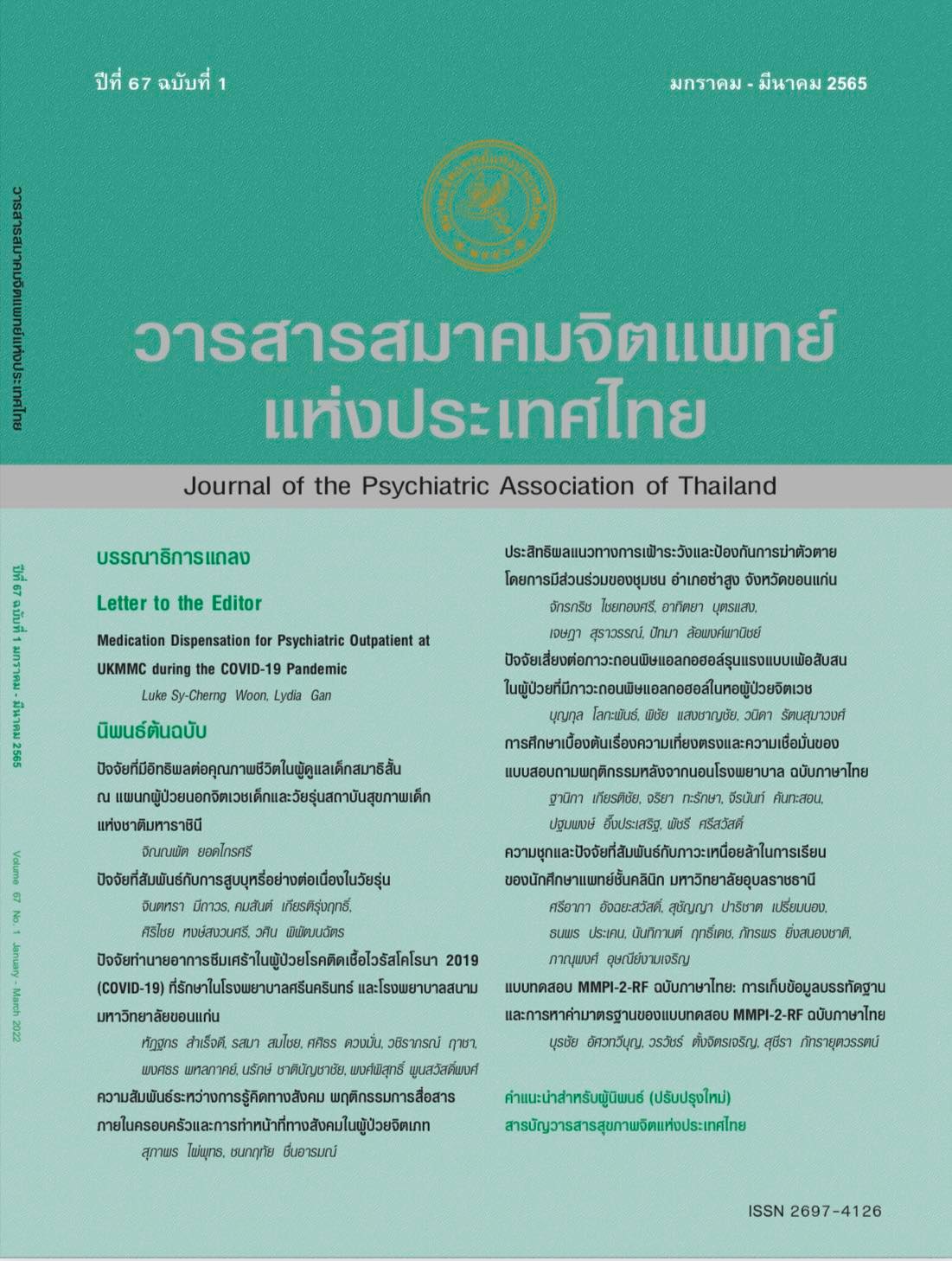Prevalence and Associated Factors of Burnout Syndrome among Clinical Medical Students, Ubon Ratchathani University
Main Article Content
Abstract
Abstract
Objective : Study prevalence and associated factors of burnout syndrome among clinical medical students, Ubon Ratchathani University.
Method : The cross-sectional study were applied on the 133 medical students in clinical years, College of Medicine and Public Health, Ubon Ratchathani University, for the academic year of 2019.The online questionnaire was consisted of demographic data, learned and practiced data and the Maslach Burnout Inventory (MBI)-Thai version. The data were analyzed using descriptive statistics consisting percentage, mean, range, standard deviation. The correlation was determined using Multiple logistic regression statistic in analyzing the influence of factors.
Results : The prevalence of burnout syndrome among clinical medical students of medical students in clinical years, it indicated 31.0% were high level of burnout syndrome. The associated factors of high level of burnout syndrome was physical illness, repeatedly in medical class, studied in Sisaket educational medical center and studied in minor ward. The associated factors of emotional exhaustion aspect was physical illness, studied in Sisaket educational medical center and negative attitude about medical study. The factor affecting burnout syndrome in depersonalization aspect was financial problem, physical illness, below average of grade point average (GPA) and studied in Sisaket educational medical center. None of the factors affecting burnout syndrome in personal accomplishment aspect.
Conclusion : One third of clinical medical students were high level of burnout syndrome. The Medical Education Center should give precedence to the medical student care both in terms of academic curriculum, screening and follow up both physical and mental illness.
Keywords : burnout syndrome, medical student
Article Details

This work is licensed under a Creative Commons Attribution-NonCommercial-NoDerivatives 4.0 International License.
Articles submitted for consideration must not have been previously published or accepted for publication in any other journal, and must not be under review by any other journal.
References
บรรณานุกรม
Maslach C, Jackson SE. The measurement of experienced burnout. J Organ Behav 1981; 2(2):99-113.
Felton JS. Burnout as a clinical entity--its importance in health care workers. Occup Med 1998; 48(4):237-50.
Sanguan Lerkiatbundit. Job burnout : Status research in Thailand, Causes and Consequences. Songklanakarin J of Social Science & Humanities 1999; 5(3):281-97.
Siraya Summawart. Burnout Among the Staff Nurses in Ramathibodi Hospital. Master's Thesis, Faculty of Medicine Ramathibodi Hospital. Mahidol University 1989.
Thomas P Reith. Burnout in United States Healthcare Professionals: A Narrative Review. Cureus 2018;10(12): e3681. DOI 10.7759/cureus.3681.
Saran Srikam, Wiroj Jiamjarasrangsi, Decha Lalitanantpong. Job burnout and related factors among residents of King Chulalongkorn Memorial Hospital. J Psychiatr Assoc Thailand 2014; 59(2):139-150.
Shanafelt TD, Boone S, Tan L, Dyrbye LN, Sotile W, Satele D, et al. Burnout and satisfaction with work-life balance among US physicians relative to the general US population. Arch Intern Med 2012; 172(18):1377-85.
Tiraya Lerthattasilp. Burnout among psychiatrists in Thailand: National survey. J Psychiatr Assoc Thailand 2011; 56(4):437-48.
Boontida Theucksuban, Raymoul Nantsupawat, Orn-Anong Wichaikhum. Factors influencing job burnout among profassional nurses in Maharajnakornsrithammarat hospital. Thai Journal of Nursing Council 2008; 23(4):114-24.
Narumol Kijjanon, Achara Jongjareonkumchok, Pornpimol Masnaragorn. Burnout among Staff Nurses Working in Intensive Care Units. Rama Nurs J 2009; 15(1): 86-97.
Ishak W, Nikravesh R, Lederer S, Perry R, Ogunyemi D, Bernstein C. Burnout in medical students: a systematic review. Clin Teach 2013; 10(4):242-5.
Gopal R, Glasheen JJ, Miyoshi TJ, Prochazka AV. Burnout and internal medicine resident work-hour restrictions. Arch Intern Med 2005; 165(22):2595-600.
Ariel Frajerman, Yannick Morvan, Marie-Odile Krebs, Philip Gorwood, Boris Chaumette. Burnout in Medical Students Before Residency: A Systematic Review and Meta-Analysis. Eur Psychiatry 2019; 55:36-42.
Chaiwat Apiwatanasiri, Krittiya Somaketrarin, Kittisak Suraprayoon, Kriwut Leurmprasert , Nootwadee Wankaew, Parkorn Homchampa, et al. Stress and Coping in Medical Students at Clinical Level, Khon Kaen University. Srinagarind Med J 2007; 22(4): 416-24.
Rungrut Rayakeaw, Wallee Satayasai. 4-6th year medical students’ stress: Case study at medical center, Buddhachinaraj Hospital, Phitsanulok. Thammasat Medical Journal 2013; 13(1):17-23.
Thomas NK. Resident burnout. JAMA 2004; 292(23):2880-9.
Maslach C, and JS, MP L. Maslach Burnout Inventory Manual. Third ed: Mind Garden Inc. 1986.
Soler JK, Yaman H, Esteva M, Dobbs F, Asenova RS, Katic M, et al. Burnout in European family doctors: the EGPRN study. Fam Pract 2008; 25(4):245-65.
Michael P. Leiter, Christina Maslach. The impact of interpersonal environment on burnout and organizational commitment. J Organ Behav 1988; 9:297-308.
Is burnout a depressive disorder? A reexamination with special focus on atypical depression. Bianchi R, Schonfeld IS, Laurent E. Int J Stress Manag 2014; 21:307–324.
Kaplan HI, Sadock BJ. Synopsis of psychiatry:behavioral sciences, clinical psychiatry.11th ed. Baltimore: William & Wilkins; 2015.


